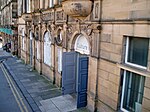Great North Museum: Hancock
1884 establishments in EnglandAC with 0 elementsArchaeological museums in EnglandBuildings at Newcastle UniversityEgyptological collections in England ... and 9 more
Museums established in 1884Museums in Newcastle upon TyneMuseums of ancient Greece in the United KingdomMuseums of ancient Rome in the United KingdomNatural history museums in EnglandNewcastle UniversityTyne & Wear Archives & MuseumsUniversity museums in EnglandUse British English from August 2015

The Great North Museum: Hancock is a museum of natural history and ancient civilisations in Newcastle upon Tyne, England. The museum was established in 1884 and was formerly known as the Hancock Museum. In 2006 it merged with Newcastle University's Museum of Antiquities and Shefton Museum to form the Great North Museum. The museum reopened as the Great North Museum: Hancock in May 2009 following a major extension and refurbishment of the original Victorian building. The museum and most of its collections are owned by the Natural History Society of Northumbria, and it is managed by Tyne & Wear Archives & Museums on behalf of Newcastle University.
Excerpt from the Wikipedia article Great North Museum: Hancock (License: CC BY-SA 3.0, Authors, Images).Great North Museum: Hancock
B1318, Newcastle upon Tyne Haymarket
Geographical coordinates (GPS) Address Phone number Website Nearby Places Show on map
Geographical coordinates (GPS)
| Latitude | Longitude |
|---|---|
| N 54.98 ° | E -1.613 ° |
Address
Newcastle University
B1318
NE1 7RU Newcastle upon Tyne, Haymarket
England, United Kingdom
Open on Google Maps








